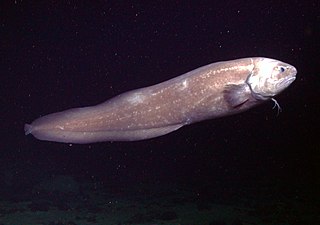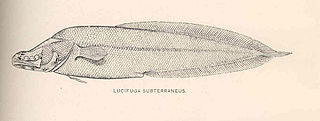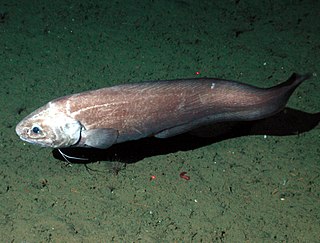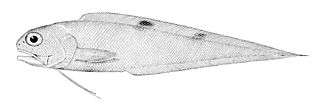
The cusk-eel family, Ophidiidae, is a group of marine bony fishes in the Ophidiiformes order. The scientific name is from the Greek ophis meaning "snake", and refers to their eel-like appearance. True eels, however, diverged from other ray-finned fish during the Jurassic, while cusk-eels are part of the Percomorpha clade, along with tuna, perch, seahorses, and others.

The cusk or tusk is a North Atlantic cod-like fish in the ling family Lotidae. It is the only species in the genus Brosme. Its other common names include torsk, European cusk, and brosmius.

Lucifuga is a genus of viviparous brotulas. Most of the species are native to caves and sinkholes in Cuba and the Bahamas; L. inopinata from deep water off the Galápagos Islands is the only exception. The four species rated by the IUCN are all considered vulnerable. The largest species in the genus reaches about 15 cm (5.9 in) in length.

Saccogaster is a genus of viviparous brotulas. They are found in the western Atlantic and Indo-Pacific.

Spectrunculus grandis is a species of Rhizopharyngia ray-finned fish in the cusk-eel family known by the common names pudgy cusk-eel and giant cusk-eel. It is one of two species in the formerly monotypic genus Spectrunculus, the other species, S. crassus, having been differentiated in 2008.
Microbrotula is a genus of viviparous brotulas.

Brotula is a genus of cusk-eels. It is the only genus is the subfamily Brotulinae.
Brotulotaenia is a genus of cusk-eels. It is the only genus in the subfamily Brotulotaeniinae.

Genypterus is a genus of cusk-eels.
Glyptophidium is a genus of cusk-eels.
Lamprogrammus is a genus of cusk-eels.

Lepophidium is a genus of cusk-eels.

Neobythites is a genus of cusk-eels.

Ophidion is a genus of cusk-eels.

Otophidium is a genus of cusk-eels, part of the subfamily Ophidiinae in the family Ophidiidae. They are found in the western Atlantic and eastern Pacific.
Parophidion is a genus of cusk-eels found in the Atlantic Ocean and the Mediterranean Sea.
Porogadus is a genus of cusk-eels.

Pycnocraspedum is a genus of cusk-eels.

Sirembo is a genus of cusk-eels of the subfamily Neobythitinae, family Ophidiidae, which are found in the Indian and Pacific Oceans. The species in this genus have a rather robust body with the dorsal fin originating over vertebrae 1–5. The head and bod are completely covered in scales, they have large eyes which are almost equal in diameter to the length of snout, the pelvic fins have two rays which are joined together within an area of tough skin, They have a short spine on the operculum which does not extend to the posterior edge of the head. Their coloration is variable but almost all species have black spots or eyespots on the dorsal fin, sometimes both, while the middle part of the anal fin frequently has a black band. The body and/or head are marked with diagonal or horizontal dark stripes or horizontal rows of quite large dusky spots.

Spectrunculus is a genus of cusk-eels found in the Atlantic and Pacific Oceans.














